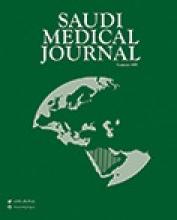Abstract
OBJECTIVE: To examine the effects of cadaveric donor age on outcomes following orthotopic liver transplantation OLT.
METHODS: Data were collected on all patients who underwent OLT between January 1997 and December 2004 at the Royal Prince Alfred Hospital, Sydney, New South Wales, Australia. During this period, 313 OLTs were performed: 51 patients 16% received older donor livers OD; 60 or more years old, and 262 84% received younger donor livers YD; less than 60 years old.
RESULTS: In the study group 313 patients, we found significantly more recipients of OD liver with blood group O: 51% versus 33% p=0.025 and with fulminant hepatic failure: 9.8% versus 5% p=0.018 compared to YD recipients. No difference between OD and YD liver recipients was found in initial poor graft function: 16/51 31% versus 74/262 28%, primary non-functioning: 6.5% versus 6.5%, the overall graft loss: 15/51 29% versus 62/262 24%, post-revascularization liver biopsy steatosis: 14/40 35% versus 82/232 36% or hepatic artery thrombosis: 1/51 2% versus 8/262 3%. There was no difference in graft actuarial survival between OD and YD recipients at 1, 3, and 5 years, 82% versus 87%, 75% versus 81%, and 75% versus 77% p=0.27 log rank or patient actuarial survival, 86% versus 89%, 79% versus 83%, and 79% versus 80% p=0.336 log rank.
CONCLUSION: Orthotopic liver transplantation can be achieved with acceptable outcomes using selected livers from older deceased donors.
- Copyright: © Saudi Medical Journal
This is an open-access article distributed under the terms of the Creative Commons Attribution-Noncommercial-Share Alike 3.0 Unported, which permits unrestricted use, distribution, and reproduction in any medium, provided the original work is properly cited.






